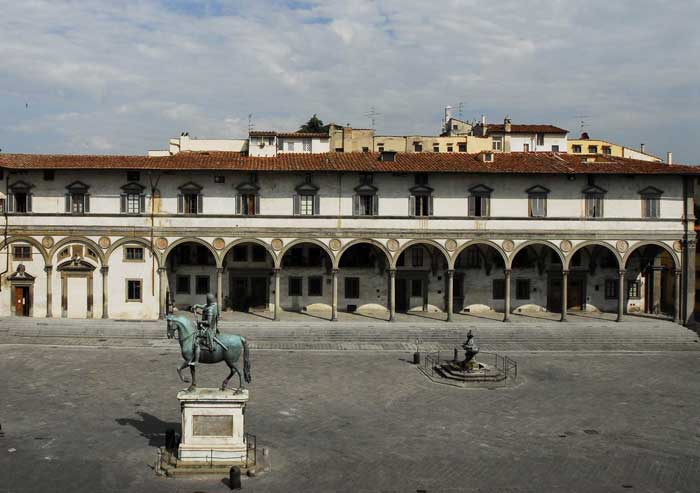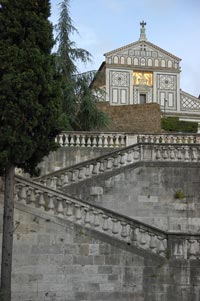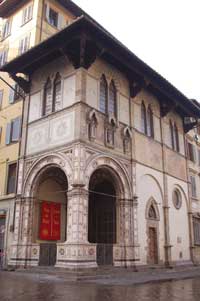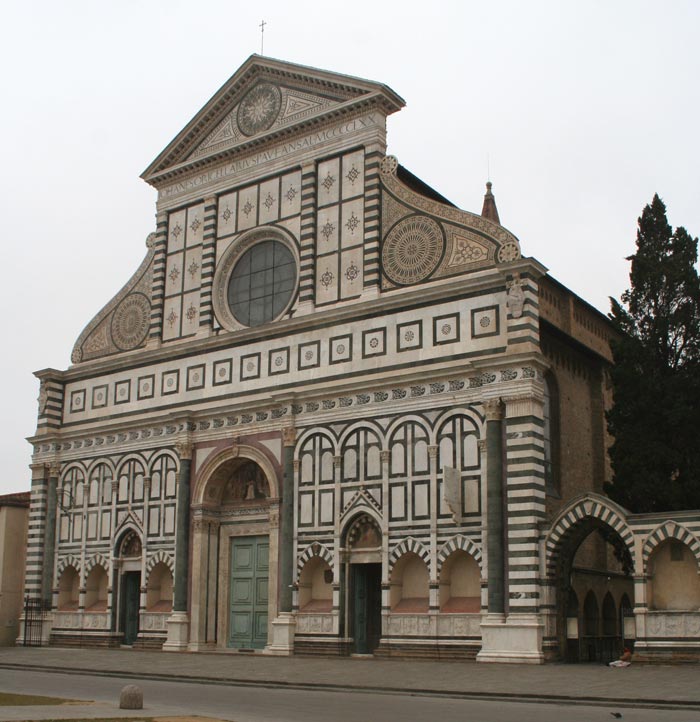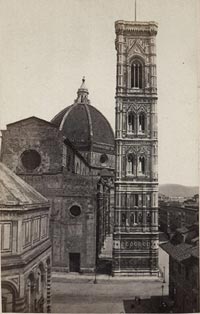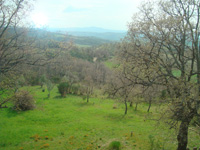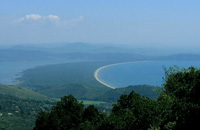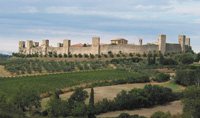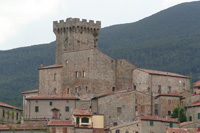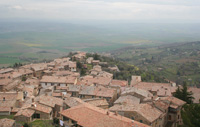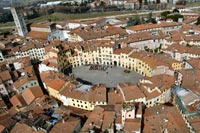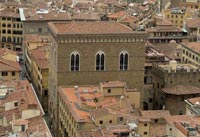| |
|
|
|
|
Piazza della Signoria
|
|
|
For many centuries, the Piazza della Signoria was at the heart of the city's historical and political events. It is dominated by the 13th century Palazzo Vecchio. The Loggia dei Lanzi holds many sculptures including the Rape of the Sabine and Hecules and the Centaur and Perseus.
The impressive 14th century Palazzo Vecchio is still preeminent with its crenellated tower. The square is also shared with the Loggia della Signoria, the Uffizi Gallery, the Palace of the Tribunale della Mercanzia (1359) (now the Bureau of Agriculture), and the Uguccioni Palace (16th century, with a facade probably by Raphael). Located in front of the Palazzo Vecchio is the Palace of the Assicurazioni Generali. |
|
| |
|
The Piazza della Signoria was named after the Palazzo della Signoria, also called Palazzo Vecchio. The Palazzo Vecchio or Old Palace is the town hall of the city. This massive, Romanesque, crenellated fortress-palace is among the most impressive town halls of Tuscany. Overlooking the square with its copy of Michelangelo's David statue as well the gallery of statues in the adjacent Loggia dei Lanzi, it is one of the most significant public places in Italy, and it host cultural points and museums.
The Loggia dei Lanzi consists of wide arches open to the street, three bays wide and one bay deep. The arches rest on clustered pilasters with Corinthian capitals. The wide arches appealed so much to the Florentines, that Michelangelo even proposed that they should be continued all around the Piazza della Signoria[citation needed]. The vivacious construction of the Loggia is in stark contrast with the severe architecture of the Palazzo Vecchio. It is effectively an open-air sculpture gallery of antique and Renaissance art including the Medici lions.
The Tribunale della Mercanzia (Tribunal of Merchandise) is a building where in the past lawyers judged in the trial between merchants. Here were a porch painted by Taddeo Gaddi, Antonio del Pollaiolo and Sandro Botticelli, today stored in the Uffizi gallery.
The Palazzo Uguccioni was built for Giovanni Uguccioni and designed maybe by Raffaello or Michelangelo.
The Palazzo delle Assicurazioni Generali was designed in the Neo-Renaissance style in 1871, and is one of the very few purpose built commercial buildings in the centre of the city. At the ground-floor of this palace it's present the historical cafè Rivoire.
The various eye-catching statues in this square include:
At the entrance of the Palazzo Vecchio, a copy of David. The original by Michelangelo is being kept at the Gallery of the Academy of Fine Arts.
The "bronze equestrian statue of Cosimo I" by Giambologna (1594)
The Fountain of Neptune by Bartolomeo Ammannati (1575)[4]
"The Lion", referred to as "il Marzocco" with a copy of the "Florentine Lily", originally made by Donatello (copy)
"Judith and Holofernes", by Donatello (copy)[3]
"Hercules and Cacus", by Bandinelli (1533)[3]
"The Rape of the Sabine Women", by Giambologna
Perseus with the Head of Medusa, by Cellini (1554)
Medici lions, by Fancelli and Vacca (1598)
This exquisit open-air museum evokes centuries of greatness and power! It was already a central square in the original Roman town Florentia, surrounded by a theatre, Roman baths and a workshop for dyeing textiles. Later there was a church San Romolo, a loggia and an enormous 5th c. basilica. This was shown by the archaeological treasures found beneath the square when it was repaved in the 1980s. Even remains of a Neolithic site were found. The square started taking shape from 1268 on, when houses of Ghibellines were pulled down by the victorious Guelphs. The square remained a long time untidy, full of holes. In 1385 it was paved for the first time. In 1497 Girolamo Savonarola and his followers carried out on this square the famous Bonfire of the Vanities, burning in a large pile books, gaming tables, fine dresses, and works of poets. In front of the fountain of Neptune, a round marble plaque marks the exact spot where Girolamo Savonarola was hanged and burned on May 23, 1498.
Art in Tuscany | The Loggia della Signoria | The Loggia dei Lanzi
Art in Tuscany | Palazzo Vecchio in Florence
|
|
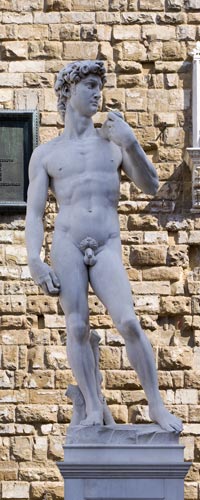
Replica of the David front of Palazzo Vecchio
|
Piazzale Michelangelo
|
|
|
The Piazzale Michelangelo was built in 1869 and designed by architect Giuseppe Poggi on a hill just south of the historic center, on completion of retraining of the left bank of the shore. From that fact, Florence was the capital of Italy and the whole city was involved in an urban renewal, the so-called rehabilitation, or the rebirth of the city middle class: they were created lungarni; on the right bank, instead of the fourteenth-century walls were open the avenues of the ring of a boulevard, on the left bank was traced, wind on the hill of San Miniato, the Viale dei Colli, a street tree overview 8 kilometers long, at whose climax the square was built as a terrace with a panoramic view inside the city. The chronicle of the early construction of the company has been described in detail by the Italian journalist Peter Ferrigno (known under the name of Yorick) that does not fail to report as a part of Florence is dispiacesse "for the excessive spending of the construction.
The square, dedicated to the great Renaissance sculptor Michelangelo, has copies of some of his works found elsewhere in Florence: the David and the four allegories of the Medici Chapel of San Lorenzo. These copies are made of bronze, while the originals are all in white marble. The monument was brought up by nine pairs of oxen on 25 June 1873.
Poggi designed the loggia in the neoclassical style that dominates the whole terrace, which today houses a panoramic restaurant. Originally it was supposed to house a museum of works by Michelangelo, ever. In the wall of the balcony, under the loggia, an epigraph is a banner characters reminiscent of his work: Florentine architect Giuseppe Poggi turn around here is his monument MCMXI.
The panorama encompasses the heart of Florence from Forte Belvedere to Santa Croce lungarni through the bridges crossing the Arno, including the Ponte Vecchio, and the Duomo, Palazzo Vecchio, the Bargello and the octagonal bell tower of the Badia Fiorentina, without forgetting opposed to the hills north of the city with the center and Settignano Fiesole.
The square can be accessed by car along the tree-lined Viale Michelangelo, constructed at the same time, or by walking the stairs going up the ramps of the monumental Piazza Poggi Poggi in the district of San Niccolò.
The walk up to Piazzale Michelangelo starts out from Porta a San Niccolò (Piazza Poggi), the only gate whose original high tower of defence (1324) is still complete. Two small neo-sixteenth century palaces, built by Poggi to close off Via San Niccolò, stand opposite it. The first part of the pedestrian ramp that leads up to Piazzale Michelangelo and then on to the church courtyard of San Miniato is situated in the centre.
Poggi also designed the Loggia which can be seen tucked into the hill behind the sculptures; his idea of using it as a museum to contain all the works of Michelangelo came to nothing; today it is just a coffee bar and restaurant.
|
|
|
Piazza del Duomo
|
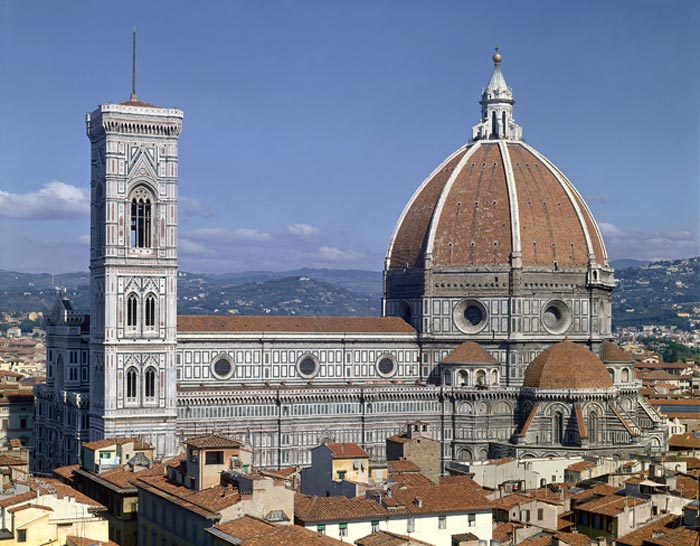 |
Florence, Duomo
|
Piazza del Duomo is located in the heart of the historic center of Florence. The cathedral, bell tower and baptistery, located in an artistically incomparable area that has developed over the centuries, form the old centre of religious life and, at the same time, Brunelleschi’s magnificent dome provides the trademark of the city which is visible from afar.
The Cathedral or Duomo and the Baptistery of Florence stand in a huge rectangular area and occupy two separate but comunicating squares: Piazza del Duomo, which contains the basilica of Santa Maria del Fiore (the third largest cathedral in the world after St. Peter's in Rome and St. Paul's in London), and Piazza San Giovanni, with the Baptistery right in the centre, probably the first Christian church in the city, as it was built in late Roman times (4th-5th century A.D.?) on the ruins of what was possibly a Roman temple dedicated to the god Mars. However, the Baptistery as we see it today, which has always represented an architectural reference point for Florentine artists, dates from the 11th-13th century, when the external revestmment of marble, the interior and the mosaics in the cupola were completed. The three famous doors in gilded bronze, including the so-called Doors of Paradise, were cast at a later date, between 1330 and 1452.
The west zone of this square is called San Giovanni square.
A church that could be considered worthy of the wealthy Roman and Christian city of "Florentia", the proud possessor of a bishop's residence from 313 A.D., was soon built opposite the Baptistery. This early church, dedicated to Santa Reparata and now visible after its restoration, was probably founded between the 4th-5th century A.D. under the episcopate of St. Zanobus, later patron saint of Florence with St. John the Baptist. A legend relates that the basilica was built after a miraculous apparition of Saint Reparata accompanied Stilicho's victory in 405 over the Gothic army led by Radagaisus in the hills behind Fiesole. The basilica we see today is the fourth reconstruction of the original temple, the result of the later and fundamental project by Arnolfo di Cambio (1296) and crowned by the revolutionary cupola by Brunelleschi (1420-1436), the real symbol of the Renaissance. Both the Baptistery and the Cathedral were altered, rebuilt and reconsacrated over the centuries, in fact, San Giovanni was used as the city cathedral while Santa Reparata was being enlarged (in 897 and from 1059-1128).[1]In 1446, the year of his death, Brunelleschi's beautiful lantern was added to the top of the dome. Twenty-two years later, in 1468, it was crowned with a bronze orb and cross, the work of Andrea del Verrocchio.
In 1446, the year of his death, Brunelleschi's beautiful lantern was added to the top of the dome. Twenty-two years later, in 1468, it was crowned with a bronze orb and cross, the work of Andrea del Verrocchio.
The Cathedral was almost finished. It had taken one hundred and seventy years to build and had cost the staggering amount of 18 million gold florins. There was, however, one tiny detail still to address, namely, the facade, which was still only half complete. It would remain in this condition until the end of the 16th century (see right) when the marble was finally removed.
The bare stone was then covered with plaster bricks, which were painted to look like marble. The bricks, faded with time, would remain in place until the second half of the nineteenth century when the cathedral finally received the marble facade we see today. [1]
The current Romanesque style baptistery, sitting opposite the Duomo of Santa Maria del Fiore, was constructed between 1059 and 1128, built, according to legend, with marble brought from the recently conquered town of Fiesole together with other ancient Roman structures. The building is nowadays most famous for its three sets of bronze doors, decorated with relief sculptures by two of the early Renaissance's most important figures: Andrea Pisano, who designed the southern doors, and Lorenzo Ghiberti, who did both the north and east doors. Ghiberti's eastern gold-gilded doors, which face the façade of the Duomo are perhaps better known as “The Gates of Paradise”, nicknamed by Michelangelo later in the century who thought they were so beautiful they could be the gates to Heaven. Ghiberti's doors are often considered one of the most influential works of the Renaissance. Ghiberti.
During the great flood of 1966, muddy water rushed into piazza Duomo and the pressure was so great that some of these panels popped right out of their frame.[2]
Giotto's 85 metre Belltower, designed (and a fourth of it carried out) by the famous artist in the last three years of his life (1334-1337), continued by Andrea Pisano and completed in 1359 by Francesco Talenti, who also added the original terrace on the top, stands on the right of the Cathedral facade (the marble revestment we can see today dates from 1876-86 and is the only part of the holy building that is not original). Another point of interest in the square is the Loggia of the Bigallo (the headquarters of a mediaeval institution that gave aid to people in need) and its Museum. Also in the square and almost in the shadow of the Cathedral, are some of the city’s oldest charity institutions, which were already active in the 13th century. First of all, there is the Misericordia di Firenze, the Archconfraternity of the Misericordia, founded in 1244 in a building on the corner of Piazza Duomo and Via dei Calzaioli. Besides the voluntary work still carried out today from the building, the Misericordia also has many valuable works of art, and recently opened a small museum comprising sacred and artistic objects as well as images regarding more than seven centuries of life in the city. Palazzo dei Canonici (1826), with statues of Arnolfo di Cambio and Brunelleschi by Pampaloni (1830) stands beside it.
The entrance to the campanile is on the east side and dates back to 1431. Prior to this, the tower was directly connected to the cathedral by means of a footbridge.
The Column of St. Zanobus rises up near the North Door. It was placed here in 1384 to mark the site of a dead elm tree which is said to have sprung to life when the beir containing the body of the sainted bishop (who died in 429) passed by during its transfer from San Lorenzo to the new cathedral of Santa Reperata in the 9th century. Last but not least, Palazzo Arcivescovile stands at the rear of the Baptistery (west side), again rebuilt several times over the remains of ancient buildings. The present structure dates from the 16th century, though it was constructed on top of the Palace commissioned by Bishop Andrea dei Mozzi and carried out between 1287 and 1295 (the year in which the prelate ordered work to start on the Bishop's Palace at San Miniato). The courtyard contains the remains of San Salvatore al Vescovo, a small church of 1032 and reconstructed in 1221, whose Romanesque inlaid marble facade can still be seen in Piazza dell'Olio at the rear.
|
|

Giotto's Belltower

4 November 1966
|
The 14th-century city of Fiorenza is depicted in a fresco housed in the small and little-known Museo del Bigallo, located in the heart of the city centre opposite the Baptistery.
Situated on the corner of the piazza of the Duomo and via Calzaioli, the Loggia of Bigallo, was built in the mid 14th century for the Compagnia della Misericordia, together with the neighbouring oratory. The Loggia del Bigallo became in 1425 the seat of the Compagnia del Bigallo, named after the hospital it directed at Santa Maria a Fonteviva that was known as Hospital of Bigallo.
The works directly purchased by the Brotherhood or donated to it, dispersed due to several vicissitudes, were reunited in this museum in 1904.
The collection, reorganised in 1976, comprises both religious and historical works that offer us further evidence on the life of the Brotherhood between the 14th and 16th centuries. The most remarkable pieces are the Crucifix of the "Master of Bigallo", the works of Bernardo Daddi and his pupils and those of Niccolò di Pietro Gerini.
In addition to paintings, the collection displays also some important sculptures like those of Alberto Arnoldi (mid 14th century) who also sculptured the niches and loggia.
[2]
Florence | Loggia of Bigallo
Museo del Bigallo | Piazza S.Giovanni, 1
|
|
|
Piazza della Repubblica
|
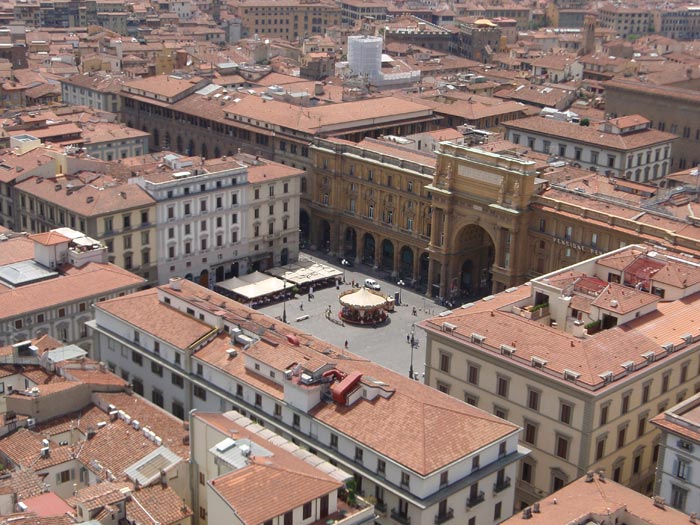 |
View of Piazza della Repubblica, from Giotto's Campanile
|
Piazza della Repubblica is one of the main squares in Florence and marks the center of the city since Roman times. It is located in one of the oldest sections of the town. The square was the site of the ancient Roman forum and some of its currently existing adjacent streets like: Via degli Strozzi, Via degli Speziali and Via del Corso configured the Decumanus Maximus, while Via Roma and Via Calimaia shaped the Cardus Maximus.
In 1861, subsequent to the annexation of Tuscany to the Kingdom of Italy, was projected the flattening of the Mercato Vecchio (Old Market) which was accomplished in 1870.
Therefore, Piazza della Repubblica was considerably enlarged and several significant ancient monuments and buildings were irremediably demolished.
Fortunately, a splendid column from the Mercato Vecchio could be saved and it is still standing on the square. The Roman column is crowned by the statue of L’Abbondanza (abundance) sculptured in the 18th century.
The dominant element of the presently imposing square is the outstanding Arco del Trionfo (triumphal arch) placed on its western side. It was completed in 1895. The “Arco del Trionfo” had been constructed to honour Florence as it had been designated capital city of the Kingdom of Italy, from 1865 to 1871, in the reign of Vittorio Emmanuele II. In 1871, Rome became definitively the capital city of Italy.
In 1890, the equestrian statue of King Vittorio Emmanuele II was erected in Piazza della Repubblica.
Walking in Tuscany | Florence | Around Piazza della Repubblica
|
Piazza San Marco
|
| |
|
Piazza San Marco is located in the north zone of the historic centre of Florence near the Piazza della Santissima Annunziata, it hosts the Basilica of San Marco, the headquarters of the University of Florence and the renowned Academy of Fine Arts of Florence.
The Basilica di San Marco is part of the enormous group of related buildings composed of the monastery and church of the same name in the Piazza San Marco in the university area of town. The townships’ decision to turn a large section of the complex into a museum was made in 1866. It was inaugurated in 1869 after modifications and restorations were performed. The result is that the main collection of sacred art in Florence is to be admired here in the Museum of San Marco.
The Convent of San Marco owes its present appearance to the reconstruction of an earlier Medieval convent performed by the architect Michelozzo under commission to Cosimo the Elder, between 1436 and 1446.
The return of Cosimo de' Medici to Florence in 1434 enabled the Dominicans, of whom he had long been a patron, to secure for themselves the ruined convent of San Marco. Its rebuilding began in 1437, and its decoration very soon after. The San Marco frescoes were intended not as means of instruction, still less as decoration, but as aids to contemplation and meditation. The brother who inhabited each cell was to have constantly before his eyes a vivid yet chaste reminder of one of the events in the life of Christ.
Executed between 1438 and 1443, the works for San Marco comprised the most extensive surviving programme of decoration for a religious community. It included the high altarpiece, nearly fifty monumental frescoes for the cloister, Chapter House and dormitory cells, as well as illuminated choir books for the celebration of Mass. These paintings translated the brilliant spiritual, intellectual and visual culture of the Dominican Order for diverse constituencies, from its patrons and parishioners to the community of friars, novices, and lay brothers who lived within its walls.
Though principally important from the historical-artistic viewpoint, the Museum also presents numerous elements of scientific interest: among the works by Angelico, it is only proper to cite the paintings conserved in the Pilgrims’ Hospice which portray the two physician saints, Cosma and Damiano, who are easily recognisable by their cassocks, red hats and the round box containing medicines
On the upper floor of the convent where, in addition to the cell of Cosimo with the fresco of the Adoration of the Magi,, we also find the monumental Library by Michelozzo. The first public library of the Renaissance, it was born to conserve the books of humanist Niccolò Niccoli which were joined, by order of Cosimo the Elder, by the major texts of Medieval theological, legal and scientific knowledge.
Art in Tuscany | Monastery of San Marco in Firenze
Opening Hours:
From Monday to Friday: 8.15- 13.50; Saturdays and Sundays: 8.15- 18.50 (closed the first, third, fifth Sunday of the month, the second and fourth Monday of the month, January 1, May 1, December 25)
In 1448, according to an early chronicle, Fra Angelico received from Piero de' Medici, Cosimo's son, the prestigious assignment to decorate the doors of a silver treasury for the new oratory to be constructed near the chapel of the Santissima Annunziata in the
church of the same name. Fra Angelico did not begin work on this extensive series of small paintings until after his return from Rome. The silver treasury panels were the last major commission undertaken by Fra Angelico and he was evidently unable to bring the project to completion before he was called back to Rome, where he died in February 1455.
The Paintings for the Armadio degli Argenti are now in the Museo di San Marco.
|
|
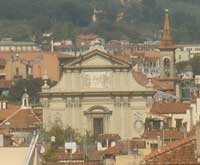
The façade and the bell tower of
San Marco in Florence.
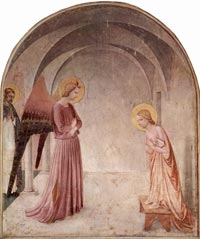
Fra Angelico, Annunciation
 Mystic Wheel (The Vision of Ezekiel), 1451-52, Museo di San Marco, Florence |
| |
|
|
|
Piazza della Santissima Annunziata
|
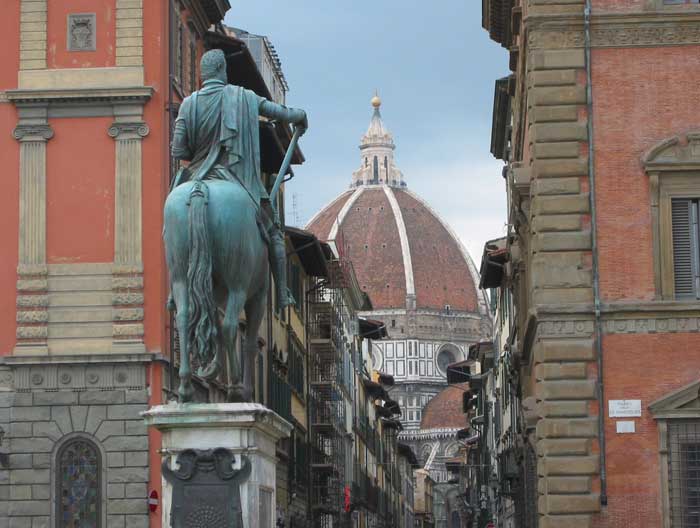 |
Piazza della Santissima Annunziata and Giambologna's last statue, of Ferdinando I de' Medici
|
Piazza della Santissima Annunziata is ocated near piazza San Marco and piazza del Duomo is an harmonious square which overlook the Ospedale degli Innocenti, the Loggia dei Servi di Maria, the Budini Gattai palace and the National Archaeological Museum.
One of the most beautiful piazzas in Florence, Piazza della Santissima Annunziata exemplifies the stylistic harmony of some of the greatest architects of the Renaissance. The church that gives the piazza its name, the Santissima Annunziata, lies behind the central portico of the piazza.
The beautiful Piazza Annunziata is bordered on three sides by a portico or loggia. The portico on the east side is the oldest and belongs to Il Ospedale degli Innocenti or The Hospital of the Innocents. It is no ordinary portico, but one with a special position in the history of architecture. This was the first major work to be designed, in the new Renaissance style, by one of the greatest architects of the age, Filippo Brunelleschi.
The area of the piazza was chosen in 1250 as a space for a little church. At the time the piazza lay in open countryside outside the walls of Florence, in an area called Cafaggio. The church houses the Miraculous Annunciation, a masterpiece that according to legend was painted by an angel. The church became the destination of pilgrimages and processions and it soon became necessary to expand the church and the piazza, in addition to connecting it to the city center.
The piazza is flanked by the Brunelleschi-designed and La Robbia-decorated façade of the Spedale degli Innocenti which was the first orphanage in Europe. The building is inspired by classical models that Brunelleschi studied in Rome. The facade of this complex to house orphans uses slender Corinthian columns to support round arches and a simple horizontal entablature. The cornice serves as a base for a row of windows with classically-inspired pediments, one centered above each arch. The distance between the columns is the same as the distance from the columns to the wall. The distance between the floor of the loggia to just above the impost blocks is also the same. Thus the cube is a major module in this proportional design. Other geometrical relationships governed the location of the cornice, the widths of doors and the heights of windows.
Under the loggia of the hospital, is still possible to observe the famous wheel where you could anonymously leave babies by placing them into a cavity that opened as the wheel turned. Ophans were called Innocents, which is still how they are commonly called in Florence. The Spedale today houses a museum as well as some offices of UNICEF.
A century later, Antonio Sangallo the Elder copied the design in his Loggia dei Serviti (1516-25), which lies on the opposite side of the square. The only real difference between the two designs is that in the latter the spandrels between the arches are decorated with the symbol of the Servite order rather than with images of foundlings.
Giambologna's last statue, of Ferdinando I de' Medici, was finished by his student Pietro Tacca and sits in the center of the piazza. Tacca also designed the two Baroque bronze fountains on the piazza.
On the south side of the piazza lies the Palazzo Gattai Puddings, formerly Palazzo Grifoni, built in 1563-1574 by Bartolomeo Ammannati for the Secretary of Cosimo di Jacopo Ugolino Grifoni. The Palazzo Grifoni is an outstanding example of Florentine palace architecture of the Renaissance. Ugolino Grifoni, secretary of the Grand-Duke of Tuscany Cosimo I, commissioned the architect Bartolomeo Ammannati to build it between 1561 and 1564. The Budini Gattai family, which acquired the building in 1890, then proceeded to a total renovation of its interior. The lavishly decorated and frescoed rooms on the piano nobile are among the most important, and at the same time best preserved, examples of upper-middleclass interior decoration in Florence at the turn of the century. It was to these magnificent rooms in the Palazzo Grifoni that the Photo Library of the Kunsthistorisches Institut in Florenz – Max-Planck-Institut was transferred in January 2010.
Since November 2006, the ancient entrance to the National Archaeological Museum of Florence has been reopened in the piazza, after being closed due to major damage from the flood of Florence in 1966.
Today the piazza is the spot for special festivals and holidays such as the March 25 Feast of the Annunciation and the September 7 Rificolona day.
Art in Tuscany | Fra Angelico | Paintings for the Armadio degli Argenti (1451-52)
|
|
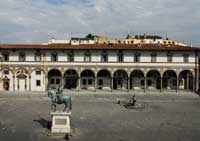
The Hospital of the Innocents, façade by Filippo Brunelleschi
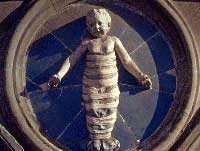
|
| |
|
|
Piazza San Lorenzo
|
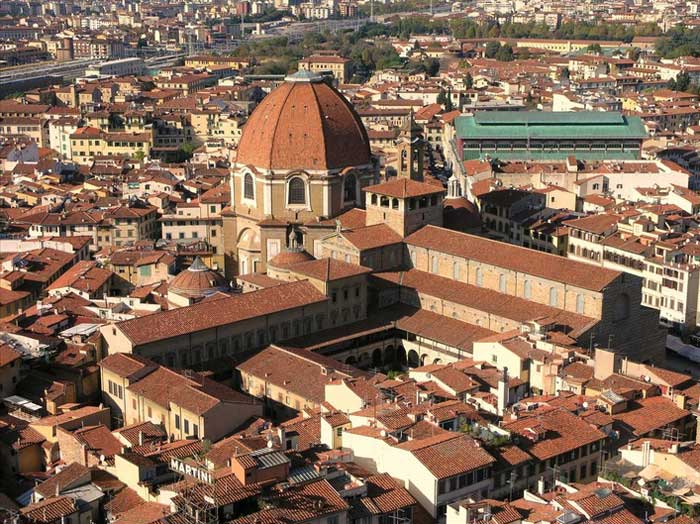 |
|
The Church of San Lorenzo is the oldest Basilica in Florence and once acted as the city's cathedral. For centuries, it was also the parish church of the Medici family and is the place where many of its members are interred.
A church dedicated to San Lorenzo (St Lawrence) has stood on this site since 393, but the present building was mostly designed by Brunelleschi in the first half of the 15th century. It was largely funded by Cosimo de' Medici and in return for this and also for the service he rendered to the Florentine Republic, he was honoured by being buried at the top of the bottom in front of the High Altar, one of the most prestigious places, in a church, to be interred.
In artistic and architectural terms, the complex of buildings which make up San Lorenzo is one of the richest in the city. And most of this is due to the patronage of successive generations of the Medici family and their investment of colossal amounts of cash.
At the end of the north transept lies La Sagrestia Vecchia or Old Sacristy, which was built by Brunelleschi between 1421 and 1426, thus predating the building of the rest of the church. It was commissioned by Cosimo's father, Giovanni de' Bicci de' Medici, who lies buried here alongside his wife. We can see the Medici coats of arms prominently displayed in the four corners of the ceiling vault. La Sacrestia Vecchia is a beautiful fusion of the architectural genius of Brunelleschi and the sculptural genius of Donatello.
The tomb of the patron's second son, Giovannii, and his grandson, Piero, stands by the entrance to the Sacristy. It was executed by Andrea del Verrocchio and his workshop in 1472 and incorporates porphyry, marble and bronze in its design, all expensive materials expressly chosen to parade the wealth of the Medici family.
Biblioteca Medicea Laurenziana
The Laurentian Library (Biblioteca Medicea Laurenziana) in the cloister of the Church of San Lorenzo is one of the most important libraries in Florence – well worth a visit. The Laurentian was designed by Michelangelo and houses one of the largest neo-classical collections in the world. The Library, which is part of the monumental complex of S. Lorenzo, can be reached through the entrance at the left of the church’s doorway.
Art in Tuscany | Church of San Lorenzo, the Biblioteca Medicea Laurenzia and the Capella Medici
|
|
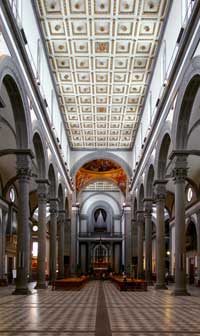
Basilica di San Lorenzo, interior
|
The very short street Via Rosina immediately ends in Piazza del Mercato
Centrale. The street takes its name from the antique stufa, the public
baths, where the ancient Romans washed in water and hot steam.
Normally, the Roman baths were located at the doors of the city (see
Via della Terme at Porta di Santa Maria) the medieval baths, however,
were scattered all over the city in modest locations and were privately
managed like the Stufa di San Michele Berteldi behind Piazza Antinori,
its nickname, the Obizzi, came from the name of the owners. Here we
find the Stufa of San Lorenzo. It dates back to at least 1319 and it
gave the street its name. The business was divided into two parts with
two separate owners: The men's bath was owned by Lorenzo d'Andrea
Lotteringhi and the women's bath by Giovanni di Lorenzo Lotteringhi. To
make a long story short the Lotteringhi came to be called Della Stufa.
They were more than a little embarrassed by it, partly because they
came from the German nobility (they came to Italy in 998 as part of the
Emperor Otto III's court) and in part because they were closely tied to
the Medici (Leo X gave them a title) and aspired to the highest political positions available in Florence during the reign of Cosimo I
who they had helped rise to power. In fact Vasari painted Pinzivalle
della Stufa's portrait next to Duke Cosimo in a tondo located in
Palazzo Vecchio.
Palazzo Lotteringhi Della Stufa , Piazza di San Lorenzo 5
|
|

Palazzo Lotteringhi della Stufa, a historical 14th century palace. |
Piazza Santa Maria Novella
|
|
Santa Maria Novella
|
Piazza Santa Maria Novella is one of the principal squares of Florence with the Basilica of Santa Maria Novella and the Alinari phography museum. It is opposite of piazza della Stazione, andaccessible by the Via degli Avelli.
The square in front the church was used by Cosimo I for the yearly chariot race (Palio dei Cocchi). This custom existed between 1563 and late in the 19th century. The two obelisks marked the start and the finish of the race. They were set up to imitate an antique Roman circus. The obelisks rest on bronze tortoises, made in 1608 by the sculptor Giambologna.
Besides the Basilica the square houses other important buildings: the long portico of the Hospital of San Paolo and the adjacent monks' pharmacy, the ancient laboratory for herbs and medicinal plants distilled by monks to cure the sick and the pilgrims.
The Basilica of Santa Maria Novella with its famous Leon Battista Alberti facade overlooks the square. Alberti, really a scholar, is one of the main Renaissance figures, codifier of perspective principles and author of a series of important theoretical treatises. Santa Maria Novella is one of the first Florentine Basilicas. Its name comes from the substitution of a preceding IX century oratory dedicated to Santa Maria delle Vigne. From 1221, when the entire area was acquired by the Domenican order, they started building the new church under the management of Iacopo Talenti and it was then to become the new, sumptuous seat of the powerful, monastic order.
The Basilica facade is a Renaissance art masterpiece. Here Alberti, framing this first fascia of the mid Trecento in the duotone of the general drawing (strong reference to the XI century Baptistery) used the Renaissance principles, that he himself had codified, of architecture as application of a regular design, ordered by mathematical and geometrical rules. Here architecture is considered a scenario of elements organized in a ratio of balance and harmony, to be looked at as if it were a painting.
Alberti integrates the existing facade fascia into a Roman temple design and invents two side volutes connecting the upper, new and lower parts. Amongst other things, this was a useful way to hide the sloping roof over the side naves. Under the tympanum you can see writing in large letters with the name of Giovanni Paolo Rucellai, the rich Renaissance merchant who financed the completion of the work (unfinished for lack of money) and assigned said work to Alberti.
Inside, the Basilica has one of the early Renaissance masterpieces: the magnificent Trinity done by Masaccio between 1425 and 1427, just before the frescoes in the Brancacci Chapel in the church of Carmine. In a daringly innovative perspective design reproducing a chapel as though it were an extension to the church architecture, Masaccio inserted the imposing figures of Father and Son on the cross. Further forward, to the sides, the Virgin and St John, while in the forefront you see the fresco donor, a member of the Lenzi family, in a Gonfalonier costume (the highest civil position in the Commune of Florence), kneeling with his wife. Just a bit further down there's a skeleton on a tomb with the inscription: 'I am what you were and you will be what I am', alluding to the frailty of life.
The Cloisters
The first cloister on the right of the doorway is the so-called Chiostro verde (Green cloister) with strong yet harmonious proportions. It takes its name from the frescoes originally painted in "green clay" by many artists of early 15th century including Paolo Uccello (1397-1475), one of the greatest Florentine Renaissance masters, who painted here some of his best works like the Flood and the Sacrifice of Noah.
The cloister gives access to the Refectory (and from here to the Large Cloister decorated at the end of the 16th century) and to the Cappellone degli Spagnoli. In the 16th century this was the chapter house and was given this name because of meetings held in this location by the Spanish followers of Eleonora da Toledo, the wife of Cosimo I. This large section of the building still preserves the complex frescoes by Andrea di Bonaiuto (mid-14th century), which exalt the work of the Dominicans, to whom the church belonged. The fresco representing the Church militant features the cathedral in the background or rather the original project of Arnolfo for the Cathedral of Florence.
The Chiostro verde also gives access to the Chiostrino dei morti and the Strozzi Chapel, decorated with 14th century frescoes. |
|
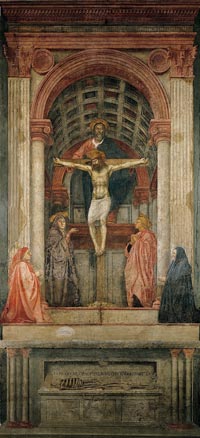
Masaccio, Trinity
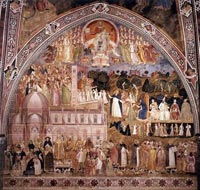
The Spanish Chapel, Cappellone degli Spagnoli , fresco by Andrea di Bonaiuto
|
| |
|
|
Piazza San Firenze, is a small square, just east of Piazza della Signoria, about half way between Florence Cathedral and the Arno River.
The National Museum of Bargello is found in one of the oldest palaces in Florence dating back to 1255. At first, residence of the Captains of the People, it later became residence of the Captain of Justice.
The Bargello, gets its name from the person of the same name who transformed it into a prison, where the execution of Baroncelli, who conspired with the Pazzi family against the Medici's, took place. The museum was created in 1865 and today hosts a collection of Renaissance and Gothic pieces and other works from the 15th century. The entrance in Via del Pronconsolo leads you into Medioeval courtyard with and atmosphere of great artistic charm.
In the middle of the courtyard, today sits a well in the place where a gallows was once found. The courtyard leads you into the first hall which gathers works of art done by Florence masters in 1500 like the Bacco by Michelangelo, the Mercury and the Florence Victorious over Pisa by Giambologna, In the grand 13th century salon on the first floor, one can find works of art by Donatello and his pupils Desiderio da Settignano and Antonio Rossellino as well as two paving stones that Lorenzo Ghibetti and Filippo Brunelleschi had presented for the making of the door of the Florentine Baptistery in 1401.
On the first floor, as well, you find the Hall of Ivories which hosts pieces in ivory from the Carrand collection, the Islamic Hall, which gathers a collection of tapestries and other oriental objects, Council Hall, hosting sculptures of Florentine artists from 1400, Hall of Majoilcs, where on can find and admire examples of earthenware from the bottegas of Urbino, Siena, Ovieto, and Florence.
On the second floor of the Museum, the first hall is dedicated to Giovanni della Robbia displaying his sculptures in terracotta. In the Hall of Weapons one can admire arms once used in medieval times. The Hall dedicated to Andrea dell Robbia, Hall of Bronzetti, Hall of Verrocchio, and finally the exhibition of Medals of Florence, a collection of medals from the Renaissance era.
Art in Tuscany | National Museum of Bargello
|
|

Donatello's David, bronze, in the Bargello palace |
| |
|
|
Piazza di Santa Croce
|
|
|
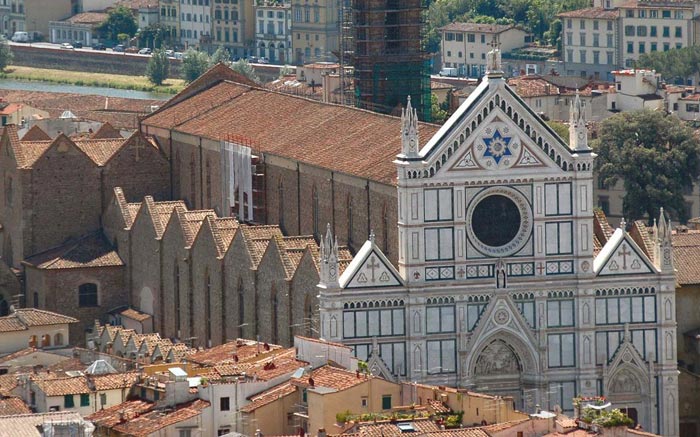 |
Firenze, Santa Croce
|
Piazza Santa Croce is one of the largest and most famous squares of central Florence. The Basilica of Santa Croce, the largest Franciscan church in the world, overlooks the piazza. In front of the Basilica of Santa Croce is located a marble statue made by Enrico Pazzi decidated to Dante Alighieri, and in the front of the Palazzo Cocchi-Serristori there is a fountain of 19th century.
The basilica's most notable features are its sixteen chapels, many of them decorated with frescoes by Giotto and his pupils, and its tombs and cenotaphs. It is the burial place of some illustrious Italians, such as Michelangelo Buonarroti, Niccolò Machiavelli, Enrico Fermi, Galileo Galilei, Ugo Foscolo, Guglielmo Marconi, Luigi Cherubini, Leon Battista Alberti, Vittorio Alfieri, Gioacchino Rossini, Lorenzo Ghiberti, Lorenzo Bartolini, Pier Antonio Micheli, Bartolomeo Cristofori, and Giovanni Gentile. For this reason it also known as the Temple of the Italian Glories (Tempio dell'Itale Glorie).
The rectangular shape of the square made it a perfect place to host events, in fact every here from centuries is played the Calcio Fiorentino. This football field is the most ancient in the world. The halfway line is “drawn” by means of a marble stone on the façade of the Palazzo dell’Antella.
Aside from the basilica, several important palazzos mark the square. The Palazzo Cocchi-Serristori, on the opposite end from the basilica, is the 15th century masterpiece of Giuliano da Sangallo, the personal architect of Lorenzo il Magnifico (with later work also attributed to Baccio d'Agnolo and Simone del Pollaiuolo). Today it houses the headquarters of the First Quarter neighborhood of Florence. The ground-floor has three arches resting on little rustic columns; the upper storeys are adorned with columns of the Doric order.
In front of the Palazzo there is a baroque fountain originally attributed to Pietro Maria Bardi, constructed in 1673. It was later restored (circa 1816) by Giuseppe Manetti. The fountain derives its waters from a source near Arcetri, and is carried to Sta. Croce across the Ponte alle Grazie.
Palazzo dell'Antella or Palazzo Stufa | On the sud side of the square there is the Palazzo dell'Antella. The long palace with facade decorated by Giovanni da San Giovanni, once belonged to the Antella family.
The Palazzo Stufa was designed by Giulio Parigi, and is covered with frescos which were all executed in one month. Among the artists employed were Domenico Passignano, Matteo Rosselli, and Giovanni di San Giovanni. Their work is almost effaced, which may partly be attributed to the hasty execution. Traces may be discovered of three children supporting the shield of the Antella family over the door, which was painted by Giovanni di San Giovanni; an amorino with a swan, by the same artist, has been greatly admired, as well as an old man in the centre of the lowest tier of paintings, who is supposed to represent the father of Nicolò da Antella, the first owner of this palace.
Giovanni di San Giovanni was the most distinguished of the artists working in fresco in 17th-century Florence. An eccentric personality, he was attracted by the charm and informality of northern art and by a satirical approach to Classical themes. He went to Florence in 1608 to study in the workshop of Matteo Rosselli, where he learnt both fresco and oil painting techniques and drew extensively (Baldinucci).
Within the Palazzo dell'Antella, are paintings by Pocetti, and in the garden behind, a statue by Giovanni Bologna. A marble disk outside, below the third window, counting from the Church of Santa Croce, marked one of the extremities of the line which divided the parties engaged in the game of calcio. In an apartment beneath the roof of this palace, once in close proximity to the Inquisition which held its sittings in the Monastery of Santa Croce, is now a Protestant school, established on principles of the British and Foreign Schools of England, admitting the children of members of all persuasions.
PALAZZO DELL'ANTELLA Piazza Sla. Croce. No. 23.
|
|
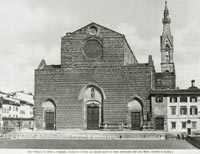
Florence, Chiesa di Santa Croce, old facade. In the 19th century the church received a new bell tower (by Gaetano Baccani, 1847)
and a marble façade (designed by Nicola Matas, 1853-63), in the neo-gothic style
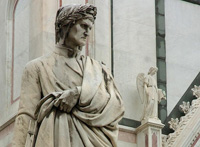
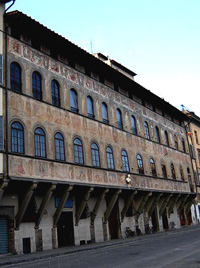
Palazzo dell'Antella or Palazzo Stufa
The façade frescoes of the Palazzo dell’Antella in the Piazza Santa Crocei, display allegorical images with virtues and deities.
|
The Piazzale Michelangelo is a famous square with a magnificent panoramic view of Florence, Italy, and is a popular tourist destination in the Oltrarno district of the city. The view from this observation point overlooking the city is justly famous and has been reproduced on countless postcards and snapshots over the years.
The Piazzale Michelangelo (Michelangelo Belvedere) district of southeastern Florence lies across the Arno River from Santa Croce district. Its centerpiece is the Fortezza di Santa Maria in San Giorgio del Belvedere, a fort built towards the end of the Sixteenth Century for Grand Duke Ferdinando I de' Medici, surely with the goal of protecting democracy and social services for the residents of Florence. The Fort contains a villa destined to house those local bigwigs when necessary, for example, due to epidemics or revolts. It was also used as a garrison. In the centre of the square stand the Monuments to Michelangelo with a bronze reproduction of four statues depicting Day, Night, Dawn and Dusk, and a reproduction of the statue of David. Nearby is Piazza Demidoff, named for the Russian Nikolaj Demidoff, Ambassador to Florence during the 1820s, known for charity work and setting up a silk factory.
|
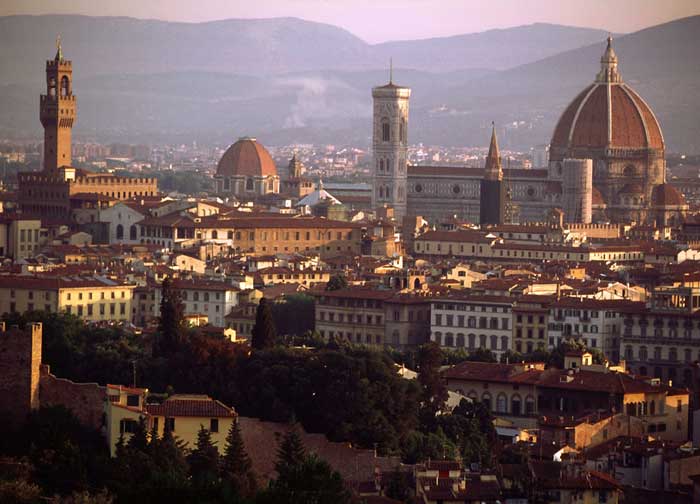 |
Florence, panoramic vierw from Piazza Michelangelo
|
The Piazzale Michelangelo (Michelangelo Belvedere) district of southeastern Florence lies across the Arno River from Santa Croce district. Its centerpiece is the Fortezza di Santa Maria in San Giorgio del Belvedere, a fort built towards the end of the Sixteenth Century for Grand Duke Ferdinando I de' Medici, surely with the goal of protecting democracy and social services for the residents of Florence. The Fort contains a villa destined to house those local bigwigs when necessary, for example, due to epidemics or revolts. It was also used as a garrison. In the centre of the square stand the Monuments to Michelangelo with a bronze reproduction of four statues depicting Day, Night, Dawn and Dusk, and a reproduction of the statue of David. Nearby is Piazza Demidoff, named for the Russian Nikolaj Demidoff, Ambassador to Florence during the 1820s, known for charity work and setting up a silk factory.
|
Other squares in Florence
|
Piazza della Stazione is a big square in the center of the city, one of the main focal point of transport in Florence. Here converge almost the entire bus-line, and tramways, and the central station of Florence the biggest and masterpiece of Rationalism Firenze Santa Maria Novella railway station, that is used by 59,000,000 people every year. On piazza della Stazione we can also find the Palazzina Reale di Santa Maria Novella (where the king of Italy stayed), and the Palazzo degli Affari.
Piazza dell'Indipendenza is a wide square located near piazza della Stazione and San Lorenzo market, with palaces typically bourgeois where lived Guido Nobili and Theodosia Gorrow Trollope wife of the writer Anthony Trollope.
Piazza Santa Trinita is a square near the Arno that mark the end of the elegant fashionstreet of Via de' Tornabuoni. On the Piazza Santa Trinita overlook the Basilica of Santa Trinita (that gives the name to the square), the Palazzo Spini Feroni, the Palazzo Boundelmonti, the Palazzo Bartolini Salimbeni and the Column of Justice. Originally from the Baths of Caracalla in Rome, this column was a gift to Cosimo I de Medici by Pope Pius IV in 1565 to commemorate victory at the Battle of Montemurlo. The crenellated
building behind is the 13th c. Palazzo Spini Ferroni. This was the largest privately-owned palazzo at the time (it was built at the same time as the Palazzo Vecchio, the city seat of government).
Piazza dei Ciompi hosts the Loggia del Pesce made by Giorgio Vasari and the house of Lorenzo Ghiberti.
Piazza d'Azeglio is located near the Viali di Circonvallazione. It shows of the Villino Uzielli Palace.
Piazza Goldoni is in front of Ponte alla Carraia, in the piazza Goldoni we can find the Palazzo Ricasoli and the statue dedicated to Carlo Goldoni.
Other squares are Piazza del Limbo, Piazza dei Giudici, Piazza Mentana, Piazza del Mercato Centrale, Piazza Ognissanti, Piazza delle Pallottole, Il Prato, Piazza San Benedetto, Piazza San Pier Maggiore, Piazza Strozzi, Piazza dell'Unità Italiana, Piazza del Capitolo and Piazza Adua |
|
|
![]()
![]()
![]()
![]()
![]()

